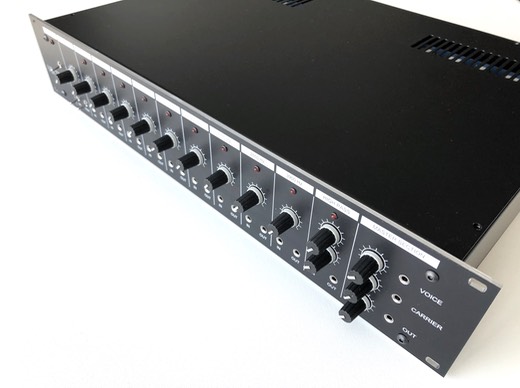Welcome
I'm a synth & electronics passionate fan and live near Antwerp, Belgium. In the mid 1990's, really young and inexperienced, I decided to build the Elektor 10 channel vocoder as described in the Dutch Elektor magazine from the early 1980’s.
In those days, board designs were published in magazines, afterwards mirrored and copied on transparent foils, heat transferred to hand drilled boards. And last but not least, ferric chloride dissolved in water was used to etch the PCB's. You might be aware that the vocoder is built on a total of 18 PCB’s. So it was a complex and nasty job to complete all the boards.
There also was no internet, no day one order and next day delivery from Mouser or Farnell, so getting all your components was quite complex and labor intensive. But I was determined to build my own vocoder and did put all my pocket money in it. Months later with the unaffordable help of my best friend, I succeeded to finish the heavily under-estimated build.
For quite a long time, I would have liked to rebuild this vocoder, but never had the courage to start this project. The initial idea was to make an exact replica as described in the Elektor magazine in the early 1980's, but with the unworthy and noxious PCB process in mind I decided to redraw all PCB's to outsource the production of them to a professional company
All the designs are customised replicas of the original electronic schemes as published by Elektor. As additional improvement the original 2-parts backplane were cropped and merged to fit on one large PCB with 15 connectors. Also the power supply has been redesigned to plug in the backplane.
What’s a vocoder?
A vocoder is an audio processor that captures the characteristic elements of an audio signal and then uses this characteristic signal to affect other audio signals. The technology behind the vocoder effect was initially used in attempts to synthesize speech. The effect called vocoding can be recognized as a talking synthesizer.
The basic component extracted during the vocoder analysis is called the formant. The formant describes the fundamental frequency of a sound and its associated noise components.
The vocoder works like this: a human voice is fed into the vocoder's input. This audio signal is sent through a series of parallel signal filters that create a signature of the input signal, based on the frequency content and level of the frequency components.
The signal to be processed, a synthesized string sound for example, is fed into another input on the vocoder. The filter signature created above during the analysis of your voice is used to filter the synthesized sound.
The audio output of the vocoder contains the synthesized sound modulated by the filter created by the human voice. The output is a synthesized sound that pulses to the tempo of your voice input with the tonal characteristics of your voice added to it.
Project history
24/12/2017 - PCB design started (basic version)
03/01/2018 - First batch PCB's ordered (basic version)
16/01/2018 - Front panel design started
25/01/2018 - First batch PCB's received (basic version)
28/01/2018 - 3D printed parts available
30/01/2018 - PCB design started (extended version)
10/02/2018 - In/out module prototype ready
11/02/2018 - Power supply 240 VAC prototype ready
31/03/2018 - All PCB's available for the basic version
01/04/2018 - Backplane prototype ready
12/05/2018 - Filter unit prototypes ready
14/05/2018 - Last batch PCB's ordered (extended version)
30/05/2018 - Official interest list available
03/06/2018 - All PCB's available for the extended version
08/06/2018 - Final front panel design ready
10/06/2018 - Sibilance expansion prototype boards ready
04/07/2018 - Front panel prototype ordered
14/07/2018 - Front panel delivered
17/07/2018 - Redesigned power supply 110/240 VAC
31/07/2018 - First assembly ongoing
18/08/2018 - Filters tested
25/08/2018 - First demo sound (basic version)
01/09/2018 - Irresistible price drop, orders accepted
09/09/2018 - Final assembly and cabling
20/09/2018 - Fully assembled and working device
22/09/2018 - Website launched
23/09/2018 - Consolidated BOM available
30/09/2018 - Interest list closed
03/10/2018 - Batch production 3D printed parts
04/10/2018 - Order forms sent out
12/10/2018 - Production run frontpanels received
25/10/2018 - Production run PCB's received
27/10/2018 - Merging kits
31/10/2018 - First shipments to Europe customers
01/11/2018 - Build thread created
07/11/2018 - Final BOM available
08/11/2018 - First shipments to US & Canada customers
17/12/2018 - All orders processed
05/01/2019 - Website updated
02/08/2020 - Second production run PCB's ordered
21/08/2020 - Second production run frontpanels ordered
22/08/2020 - Batch production 3D printed parts
12/09/2020 - Second production run PCB's received
14/09/2020 - Second production run frontpanels ordered
20/09/2020 - Merging kits
30/09/2020 - New kits available
08/11/2020 - Renewed assembly & adjustment instructions
31/12/2020 - Project successfully closed
Vocoder specifications
Number of channels:
Low pass filter: 1
Band Filters: 8
High pass filter: 1
Overview PCB’s:
Backplane
Power supply & protecting cover
Input/output module
Low pass filter
8 consecutively band pass filters
High pass filter
Noise generator
Detecting interface
Commutation interface
Voice input:
Sensitivity: 7,7 mV … 7,7 V
Impedance: 10 kOhm
Carrier input:
Sensitivity: 770 mV
Impedance: 100 kOhm
Line out:
Output voltage: 770 mV
Freqency range:
30 … 16.000 Hz
